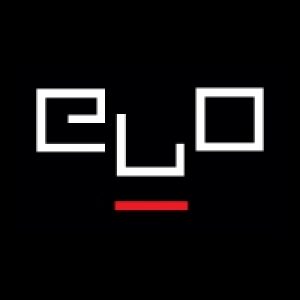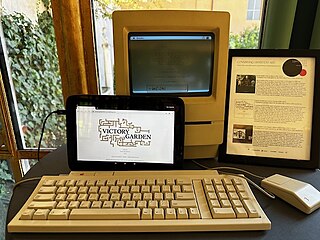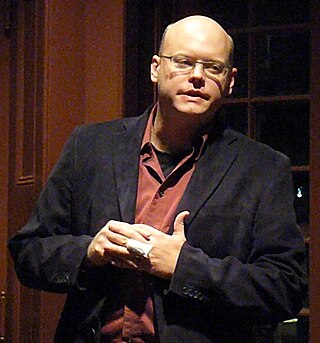Related Research Articles

Hypertext is text displayed on a computer display or other electronic devices with references (hyperlinks) to other text that the reader can immediately access. Hypertext documents are interconnected by hyperlinks, which are typically activated by a mouse click, keypress set, or screen touch. Apart from text, the term "hypertext" is also sometimes used to describe tables, images, and other presentational content formats with integrated hyperlinks. Hypertext is one of the key underlying concepts of the World Wide Web, where Web pages are often written in the Hypertext Markup Language (HTML). As implemented on the Web, hypertext enables the easy-to-use publication of information over the Internet.

Robert Lowell Coover is an American novelist, short story writer, and T. B. Stowell Professor Emeritus in Literary Arts at Brown University. He is generally considered a writer of fabulation and metafiction.
Hypertext fiction is a genre of electronic literature, characterized by the use of hypertext links that provide a new context for non-linearity in literature and reader interaction. The reader typically chooses links to move from one node of text to the next, and in this fashion arranges a story from a deeper pool of potential stories. Its spirit can also be seen in interactive fiction.
Digital poetry is a form of electronic literature, displaying a wide range of approaches to poetry, with a prominent and crucial use of computers. Digital poetry can be available in form of CD-ROM, DVD, as installations in art galleries, in certain cases also recorded as digital video or films, as digital holograms, on the World Wide Web or Internet, and as mobile phone apps.
Electronic literature or digital literature is a genre of literature where digital capabilities such as interactivity, multimodality or algorithmic text generation are used aesthetically. Works of electronic literature are usually intended to be read on digital devices, such as computers, tablets, and mobile phones. They cannot be easily printed, or cannot be printed at all, because elements crucial to the work cannot be carried over onto a printed version.

afternoon, a story, spelled with a lowercase 'a', is a work of electronic literature written in 1987 by American author Michael Joyce. It was published by Eastgate Systems in 1990 and is known as one of the first works of hypertext fiction.
George Paul Landow was Professor of English and Art History Emeritus at Brown University. He was a leading authority on Victorian literature, art, and culture, as well as a pioneer in criticism and theory of Electronic literature, hypertext and hypermedia. He also pioneered the use of hypertext and the web in higher education.

The Electronic Literature Organization (ELO) is a nonprofit organization "established in 1999 to promote and facilitate the writing, publishing, and reading of electronic literature". It hosts annual conferences, awards annual prizes for works of and criticism of electronic literature, hosts online events and has published a series of collections of electronic literature.

Patchwork Girl or a Modern Monster by Mary/Shelly and Herself is a work of electronic literature by American author Shelley Jackson. It was written in Storyspace and published by Eastgate Systems in 1995. It is often discussed along with Michael Joyce's afternoon, a story as an important work of hypertext fiction.

Victory Garden is a work of electronic literature by American author Stuart Moulthrop. It was written in StorySpace and first published by Eastgate Systems in 1991. Victory Garden is one of the earliest examples of hypertext novels, and is notable for being very inventive and influential in its genre. It is often discussed along with Michael Joyce's afternoon, a story as an important work of hypertext fiction.
Stuart Moulthrop is an innovator of electronic literature and hypertext fiction, both as a theoretician and as a writer. He is author of the hypertext fiction works Victory Garden (1992), which was on the front-page of the New York Times Book Review in 1993, Reagan Library (1999), and Hegirascope (1995), amongst many others. Moulthrop is currently a Professor of Digital Humanities in the Department of English, at the University of Wisconsin–Milwaukee. He also became a founding board member of the Electronic Literature Organization in 1999.
Eastgate Systems is a publisher and software company headquartered in Watertown, Massachusetts, which publishes hypertext.
Judy Malloy is an American poet whose works embrace the intersection of hypernarrative, magic realism, and information art. Beginning with Uncle Roger in 1986, Malloy has composed works in both new media literature and hypertext fiction. She was an early creator of online interactive and collaborative fiction on The WELL and the website ArtsWire.
Marjorie Coverley Luesebrink was an American writer, scholar, and teacher. Writing hypermedia fiction under the pen name M.D. Coverley, she is best known for her epic hypertext novels Califia (2000) and Egypt: The Book of Going Forth by Day (2006). A pioneer born-digital writer, she is part of the first generation of electronic literature authors that arose in the 1987–1997 period. She was a founding board member and past president of the Electronic Literature Organization and the first winner of the Electronic Literature Organization Career Achievement Award, which was named in her honor. Lusebrink was professor emeritus, School of Humanities and Languages at Irvine Valley College (IVC).

Scott Rettberg is an American digital artist and scholar of electronic literature based in Bergen, Norway. He is the co-founder and served as the first executive director of the Electronic Literature Organization. He leads the Center for Digital Narrative, a Norwegian Centre of Research Excellence from 2023 to 2033.
John Howland Cayley is a Canadian pioneer of writing in digital media as well as a theorist of the practice, a poet, and a Professor of Literary Arts at Brown University.
Jessica Pressman is a scholar who studies electronic literature including digital poetry, media studies, and experimental literature. She creates works that examine how technologies affect reading practices that are displayed through several media forms.
Generative literature is poetry or fiction that is automatically generated, often using computers. It is a genre of electronic literature, and also related to generative art.
34 North 118 West by Jeff Knowlton, Naomi Spellman, and Jeremy Hight is one of the first locative hypertexts. Published in 2003, the work connected Global Positioning System (GPS) data with a fictional narrative on an early tablet PC connected to Global Positioning devices to deliver a real-time story to a user.
References
- ↑ "issue:03: counter-works". The Digital Review. Retrieved 14 November 2023.
- ↑ "Drunken Boat". drunkenboat.com. Retrieved 2023-11-21.
- ↑ Hayles, N. Katherine (2008). Electronic Literature: New Horizons for the Literary (1 page 6, 7 ed.). Indiana: University of Notre Dame. ISBN 978-0-268-03084-1.
- ↑ "Electronic Literature Collection". Electronic Literature Collection. Retrieved 19 November 2023.
- ↑ "Electronic Literature Knowledge Base". ELMCIP. Retrieved 19 November 2023.
- ↑ "Geodes :: locative and creative". geodes.io. Retrieved 2023-11-21.
- ↑ "Homepage". New Media Writing Prize. Retrieved 2023-11-21.
- ↑ "The New River". The New River. Retrieved 19 November 2023.
- ↑ "The New River: A Journal of Digital Writing and Art Collection". The NEXT Museum.
- ↑ Moulthrop, Stuart; Grigar, Dene (2017). Traversals: the use of preservation for early electronic writing. Cambridge, Massachusetts: The MIT Press. ISBN 978-0-262-03597-2.
- ↑ "La Revue". revuebleuorange.org (in French). Retrieved 2023-10-01.
- ↑ trAce, frAme. "FrAme Journal". ELO Next. Electronic Literature Organization. Retrieved 19 August 2022.
- ↑ "3 X 3: New Media Fix(es) on Turbulence" (PDF). Turbulence. November 16, 2022.
- ↑ Menon, Nirmala; T, Shanmugapriya; Joseph, Justy; Sutton, Deborah (2023-12-13). Indian Electronic Literature Anthology. Indian Institute of Technology – Knowledge Sharing in Publishing. doi:10.57004/book1/. ISBN 978-93-5811-313-6.
- ↑ "Talan Memmitt". ELMCIP. Retrieved 23 November 2023.
- ↑ (2007.) "Interview: Caterina Davinio." Archived 2011-10-01 at the Wayback Machine Jip.javamuseum.org. Accessed December 2011.
- ↑ "Citations search: "N. Katherine Hayles" (Google Scholar)" . Retrieved 2008-01-18.
- ↑ Lev Manovich Archived 2010-06-25 at the Wayback Machine faculty profile at European Graduate School, Saas-Fee
- ↑ Walker, Jill (1999). "Piecing together and tearing apart". Proceedings of the tenth ACM Conference on Hypertext and hypermedia : Returning to our diverse roots: Returning to our diverse roots. Darmstadt Germany: ACM. pp. 111–117. doi:10.1145/294469.294496. hdl: 1956/1073 . ISBN 978-1-58113-064-5. S2CID 17335695.
- ↑ Rettberg, Jill Walker (2014). "Visualising Networks of Electronic Literature: Dissertations and the Creative Works They Cite". Electronic Book Review.
- ↑ Douglas, J. Yellowlees (2000). The end of books or books without end ? reading interactive narratives. Ann Arbor (Mich.): University of Michigan press. ISBN 978-0-472-11114-5.
- ↑ Davinio, Caterina (2002). Tecno-Poesia e realtà virtuali (in Italian). Sometti. ISBN 9788888091853 . Retrieved 23 November 2023.
- ↑ Hayles, Nancy Katherine; Burdick, Anne; Lunenfeld, Peter (2002). Writing machines. Mediawork pamphlet. Cambridge, Mass: MIT Press. ISBN 978-0-262-58215-5.
- ↑ Malloy, Judy, ed. (2003). Women, art, and technology. Leonardo. Cambridge, Mass.: MIT Press. ISBN 978-0-262-13424-8.
- ↑ The Aesthetics of Net Literature (PDF). Transcript Verlag, Bielefeld. 2007. ISBN 978-3-89942-493-5 . Retrieved 23 November 2023.
- ↑ Landow, George P. (2006). Hypertext 3.0: critical theory and new media in an era of globalization. Parallax (3rd ed.). Baltimore (Md.): Johns Hopkins university press. ISBN 978-0-8018-8256-2.
- ↑ Bell, Alice (2010). The possible worlds of hypertext fiction (Thesis). Basingstoke: Palgrave Macmillan. ISBN 9780230542556.
- ↑ Eskelinen, Markku (2012). Cybertext poetics: the critical landscape of new media literary theory. International texts in critical media aesthetics. London: Continuum. ISBN 978-1-4411-2438-8.
- ↑ Koenitz, Hartmut; Ferri, Gabriele; Haahr, Mads; Sezen, Digdem; Sezen, Tonguc Ibrahim, eds. (2015). Interactive digital narrative: history, theory, and practice. Routledge studies in European communication research and education. London New York: Routledge. ISBN 978-1-138-78239-6.
- ↑ Tabbi, Joseph (2018). The Bloomsbury handbook of electronic literature. London, UK: Bloomsbury academic, an imprint of Bloomsbury publishing Plc. ISBN 978-1-4742-3025-4.
- ↑ Electronic Literature. Polity. January 2019. ISBN 978-1-509-51677-3 . Retrieved 23 November 2023.
- ↑ Ensslin, Astrid; Bell, Alice (2021). Digital fiction and the unnatural: transmedial narrative theory, method, and analysis. Theory and interpretation of narrative. Columbus: The Ohio State University Press. ISBN 978-0-8142-1456-5.
- ↑ Ensslin, Astrid (2022). Pre-web digital publishing and the lore of electronic literature. Cambridge elements publishing and book culture. Cambridge: Cambridge University Press. ISBN 978-1-108-82888-8.
- ↑ "Hyperfiction: Novels for the Computer". archive.nytimes.com. Retrieved 2023-11-25.
- ↑ Coover, Robert (1993-08-29). "HYPERFICTION; And Now, Boot Up the Reviews". The New York Times. ISSN 0362-4331 . Retrieved 2023-11-25.
- ↑ Hayles, N. Katherine (2008). Electronic Literature: New Horizons for the Literary (1 page 23 ed.). Indiana: University of Notre Dame. ISBN 978-0-268-03084-1.
- ↑ Hayles, N. Katherine (2008). Electronic Literature: New Horizons for the Literary (1 page 23 ed.). Indiana: University of Notre Dame. ISBN 978-0-268-03084-1.
- ↑ "Storyland by Nanette Wylde". variants.artbase.rhizome.org. Retrieved 2023-11-29.
- ↑ "Electronic Literature Organization". eliterature.org. Retrieved 2023-12-14.
- ↑ Szilak, Illya (7 March 2013). "It's All Fun Until Someone Loses: E-lit Plays Games". Huffington Post.
- ↑ "Past ELO Award Winner". Electronic Literature Organization. Retrieved 20 November 2023.
- ↑ "NMWP". New Media Writing Prize. Retrieved 20 November 2023.
- ↑ "Woollahra Digital Literary Award". Woollahra Municipal Council. Retrieved 20 November 2023.
- ↑ "ENG 2360: American Literature and the Arts – English 2360: American Literature and the Arts" . Retrieved 2024-04-20.
- ↑ "The Materials of Poetry – English 3740: Studies in Poetry". 2022-12-12. Retrieved 2024-04-20.
- ↑ "Electronic Literature and Digital Writing – Just another My Sites site". 2022-06-17. Retrieved 2024-04-20.
- ↑ "Postmodern Experimental Poetry – English 4795/6 – Spring 2021 – Prof. Leonardo Flores". 2023-05-01. Retrieved 2024-04-20.
- ↑ "Syllabus". Text in Art. 2018-09-09. Retrieved 2024-04-21.